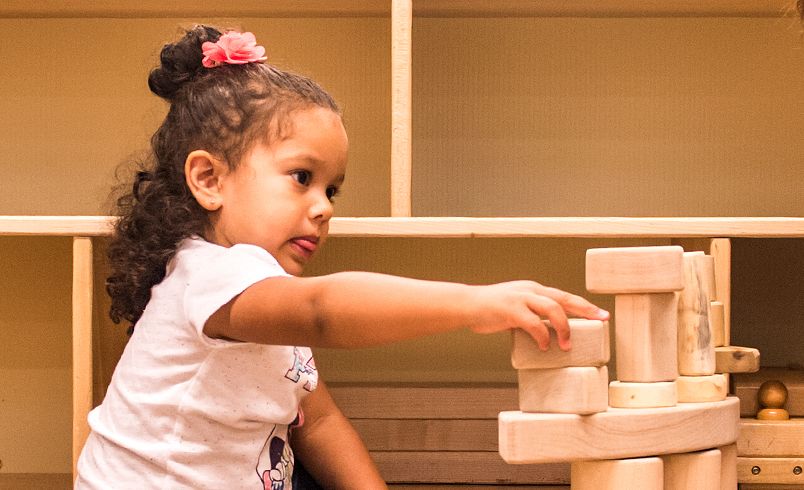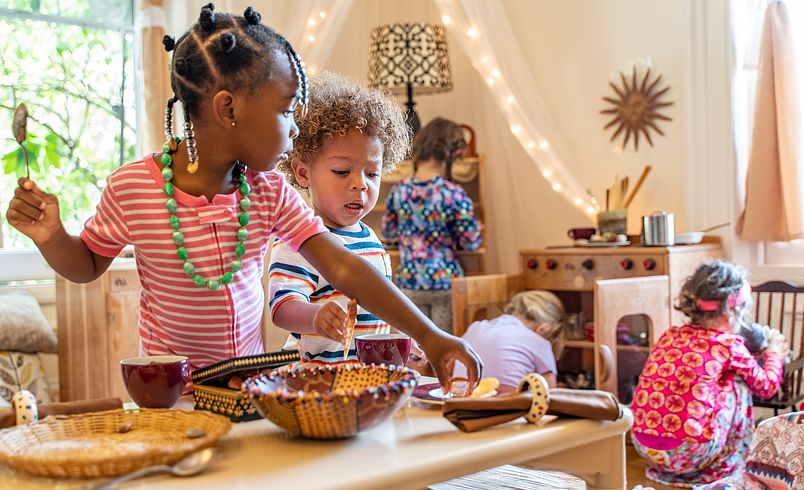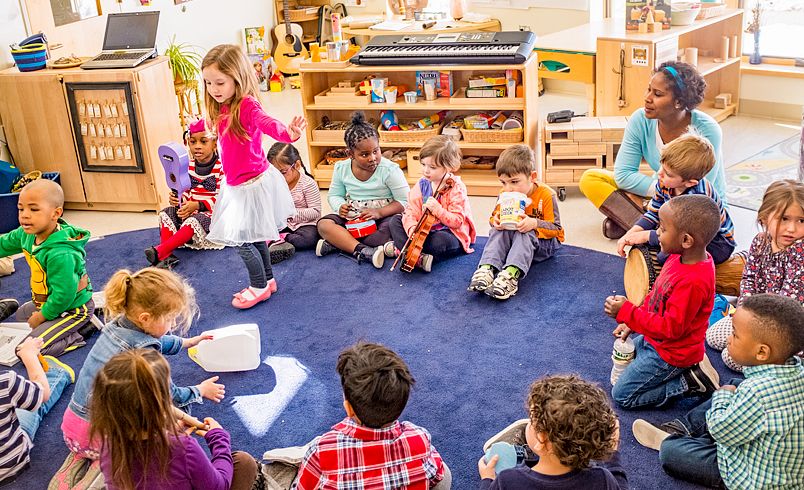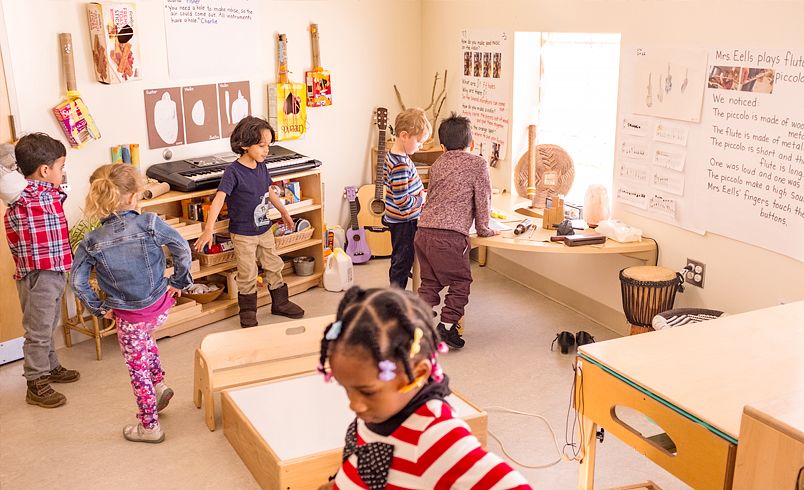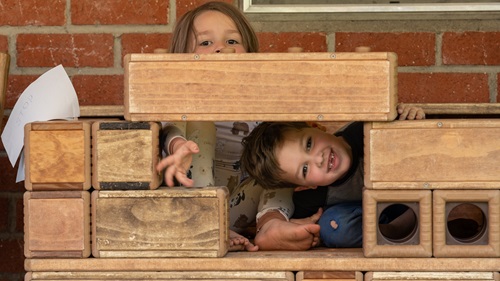Celebrating the Whole Child
Putting the Pieces Back Together
| November 2022Over the last decade, the early childhood field has focused in on parts or pieces of children’s development. This outlook has produced approaches such as STEM (or STEAM) and SEL (Social Emotional Learning) as well as igniting debates such as Literacy vs. Phonics. Each approach emphasizes a particular area or areas of a child’s development. The pushdown of academic testing has added pressure to this compartmentalization of learning as well. It is important to remember, however, that a young child is a whole, realistic, and curious person. Now it is time to put all the pieces back together and focus on integrating these areas into holistic early childhood programs.
The Puzzle Pieces
During the first years of a young child’s life, an amazing amount of physical, emotional, and cognitive growth occurs. As we think about integrating learning, it is important to consider all areas and aspects of development.
Cognitive Development includes the ability to think, solve problems, and determine unique solutions. The foundation for these skills is established and supported during the early years by allowing children to learn actively, use concrete materials, and explore varied possibilities.
Language Development exponentially explodes during the first years of a child’s life. This area of development is best supported through a language-rich environment where interactive conversations occur, and children’s voices are heard. Books and stories are widely used, expanding possibilities by providing enriched vocabulary, oral fluency, and comprehension.
Social Development, which is the ability to work with others, includes establishing relationships between both children and adults. This important life skill is supported best through child-directed play, giving children many opportunities to learn to cooperate and collaborate with others.
Emotional Development, relates to the gradual process whereby children acquire an understanding, experiences, expressions, and become able to manage their emotions. Some of the important aspects of this domain related to self-awareness, self-regulation, and establishing relationships. A caring environment, that values and respects each child, can help build a foundation for emotional development during the critical early years.
Physical development, which includes small and large motor skills, is being refined during these early years. This requires children to be actively involved while participating in meaningful, physical experiences. In the early years, the focus should be on participation, not competition. There is also a new interest in ensuring that some physical activity occurs every day, outdoors.
Each of these areas of a child’s development are interconnected; impacting and interacting constantly with the other domains. How can we integrate all these areas in our classrooms so that children can develop holistically?
Putting the Puzzle Back Together
The most meaningful and engaging learning in the early years is integrated learning. In these experiences, all the domains are woven together, responding to the natural development of the child. There are many effective ways to weave these areas together in your classroom:
Child Directed Play
Child-directed play is the most powerful form of integrated learning encompassing all the learning domains. In play, children can participate at their development level, attempt a wide variety of skills, explore roles, and develop persistence. They can converse, solve conflicts, and make decisions. Given enough space and scope, child-directed play can involve large amounts of physical activity as well, particularly outdoors. By including unique and varying materials both in your classroom and in your outdoor space, you can encourage a wide variety of play themes, stimulating creativity, language, and physical development.
Small Groups
Dividing your class into small groups is another effective way to integrate many domains. If a small-sized group (3-5 young children) works together, there are more opportunities for them to talk, discuss, collaborate, and influence the outcomes obtained from the group work. An informal way of facilitating small group work in the early childhood classroom is creating Play/Learning Centers. These can be designed by the teacher or inspired by an interest demonstrated by the children. Children can make decisions and choose to go to an area they wish, select their own materials, and shape the events that occur within this space. Active learning through small groups provides a way to integrate many developmental areas but also supports personally meaningful engagement in a space where choices can be made to implement children’s own ideas. These small groups allow the teacher to value and comment on these ideas, support children’s efforts, and encourage persistence.
Inclusion of the Arts
The arts—music, visual arts, creative drama, and movement—are great ways to integrate learning. Participation in an artistic experience nurtures many domains as children talk and work with other children, share their creations with classmates, and use their bodies as they move and dance to music. While research has shown the power of music to activate the brain, it is still an underused tool in many early childhood programs.
Even if you don’t have the Arts built into your program, you can include them into every aspect of your curriculum by making materials and equipment available to the children on a daily basis. Instruments such as rattles, drums, or xylophones invite musical exploration. Weave singing into your daily routines and transition times. Encourage the dramatization of favorite stories. Young children can retell the story or create their own theme variation. Books and stories can be selected to expand areas of interest, pose a new adventure, or encourage positive social interactions.
The visual arts provide many possibilities to integrate all the domains as well. As children create with paint, clay, or loose materials they are presented with choices: what colors will they use, what materials will they combine, what will they name their work, how will they display it for others to see? Art naturally promotes the development of fine motor skills as children work with a variety of materials. Working collaboratively on a project or in close proximity to other children in the art area provides great chances to practice social skills.
The Project Approach
Using the Project Approach in your classroom is another natural way of incorporating learning across all the domains. Projects can be individual, collaborative with a partner, or in small groups that follow a specific interest, topics, or solve a question. They can be short-term, or as we have learned from Reggio Emilia approach, they can be long-term, continuing over weeks, months, or even a year.
During the process of identifying what the project will be, there is much discussion, questioning, and exploration of possibilities. During the project work, children research, make adjustments, and try variations. This active learning requires thinking, discussion, listening to others, and deciding which ideas to follow and which ones to discard. Their work is collaborative, creative, and engaging.
Positive Lifetime Outcomes
In today’s early childhood classroom, educators play a vital role in designing environments, interactions, and experiences that will support holistic learning. Envisioning the child as a whole, curious, creative, and capable individual is vital to this approach. Weaving all the developmental domains together encourages the budding capacities of young children. These critical early years are a time for developing the foundation for learning. Creating this foundation will ensure positive lifetime outcomes for our young children.
References
National Research Council 2000. From Neurons to Neighborhoods: The Science of Early Childhood Development. Washington, DC: The National Academies Press. https://doi.org/10.17226/9824.
Isbell, R. & Yoshizawa, S. A. (2016). Nurturing Creativity: The Essential Mindset for Young Children’s Learning. National Association for the Education of Young Children. Washington, DC.

